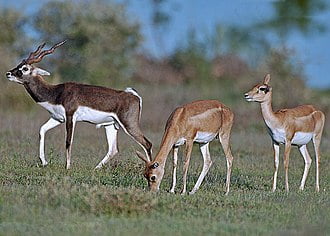Antelope

The term antelope is used to refer to many species of even-toed ruminant indigenous to various regions in Africa and Eurasia.
Antelope comprise a wastebasket taxon (miscellaneous group) within the family Bovidae, encompassing all Old World ruminants that are not bovines, sheep, or goats. A group of antelope is called a herd.
Unlike deer antlers, which are shed and grown annually, antelope horns grow continuously.
The English word “antelope” first appeared in 1417 and is derived from the Old French antelop, itself derived from Medieval Latin ant(h)alopus, which in turn comes from the Byzantine Greek word ἀνθόλωψ, anthólops, first attested in Eustathius of Antioch (c. 336), according to whom it was a fabulous animal “haunting the banks of the Euphrates, very savage, hard to catch and having long, saw-like horns capable of cutting down trees”. It perhaps derives from Greek ἀνθος, anthos (flower) and ώψ, ops (eye), perhaps meaning “beautiful eye” or alluding to the animals’ long eyelashes.
This, however, may be a later folk etymology. The word talopus and calopus, from Latin, came to be used in heraldry. In 1607, it was first used for living, cervine animals.
The 91 antelope species, most of which are native to Africa, occur in about 30 genera. The classification of tribes or subfamilies within Bovidae is still a matter of debate, with several alternative systems proposed.
Antelope are not a cladistic or taxonomically defined group. The term is used to describe all members of the family Bovidae that do not fall under the category of sheep, cattle, or goats. Usually, all species of the Alcelaphinae, Antilopinae, Hippotraginae, Reduncinae, Cephalophinae, many Bovinae, the grey rhebok, and the impala are called antelope.
More species of antelope are native to Africa than to any other continent, almost exclusively in savannahs, with 20-35 species co-occurring over much of East Africa.[4] Because savannah habitat in Africa has expanded and contracted five times over the last three million years, and the fossil record indicates this is when most extant species evolved, it is believed that isolation in refugia during contractions was a major driver of this diversification.
Other species occur in Asia: the Arabian Peninsula is home to the Arabian oryx and Dorcas gazelle. India is home to the nilgai, chinkara, blackbuck, Tibetan antelope, and four-horned antelope, while Russia and Central Asia have the Tibetan antelope, and saiga.
